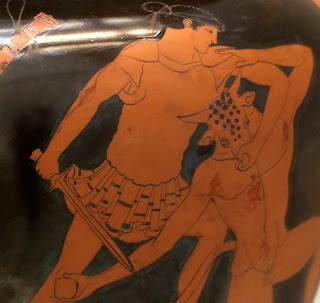There’s a
play I want to see which hasn’t been written.
Scary words. The last time I
wrote a sentence like that - well I’m still adventuring through the
consequences of that statement.
Nevertheless, there is a play I badly want to see which hasn’t been
written.
Just over a
week ago we had the great good fortune to see the NTLive broadcast of George
Bernard Shaw’s Man and Superman with
Indira Varma and Ralph Fiennes directed by Simon Godwin. It’s my favorite Shaw play, I consider it his
best, and I’ve only seen it performed once before, (an exquisite production
years ago in Cambridge, Massachusetts.)
It’s rarely staged in it’s entirely both because of its length and, more
importantly, the immense technical challenge it poses for the actors. If King
Lear is an Everest, Man and Superman
is a K2.


Then, there were the terrorist attacks in Tunisia and France this week. The personal tragedies of the victims and the sorrow and uncertainty their families are enduring brought me back to the immediacy of what has been an historical week in so many ways. When I ruminate about the Middle East, I always come back to T. E. Lawrence who accomplished his ambition to make history and chronicle it and thence foresaw the anguish the region would endure. I would argue that Seven Pillars of Wisdom generally, but accurately prophesied the future of the region up through the 1990s. I wonder what he would make of it now.
Shaw and
Lawrence knew each other in the 1920s.
Lawrence was in his early thirties, wrestling with the legacy of
historical achievement and his wild, brilliant lion of a memoir, grieving over
fundamental issues like style and length.
Shaw was in his sixties, lionized, married to a woman who was also a
formidable literary companion and feminist activist, Charlotte Payne-Townsend.
Jeremy
Wilson, in his seminal biography of Lawrence, writes of his state of mind at
the time,
…The
romantic Victorian concepts that he had so willingly adopted in his youth were
one by one falling away. His evangelical
Christianity had faded before the war; at Uxbridge he had written: ‘Hungry time
has taken from me year by year more of the Creed’s clauses, till now only the
first four words remain. Them I say
defiantly, hoping that reason may be stung into new activity when it hears
there’s yet a part of me which escapes its rule.’ The vision of the ‘noble savage,’ which had
been a guiding principle during his Carchemish years, had crumbled during the
Arab Revolt…He had abandoned one of the fundamental tenets of his Victorian
upbringing: belief in the progress of
mankind, and now he had concluded that romantic love, a concept he had been
brought up to revere, was nothing more than animal lust.
In contrast, consider the implicit optimism in this short excerpt from Man and Superman in which Jack Tanner is trying to discover the fundamental principles of male and female psychology,
…the
artist’s work is to show us ourselves as we really are. Our minds are nothing but this knowledge of
ourselves; and he who adds a jot to such knowledge creates new mind as surely
as any woman creates new men.
Lawrence was imprisoned by experience and values in a dark world view, whereas, Shaw, against such odds, was working to discover and define an optimistic vision of human purpose.
And that is
the play I want to see: a portrayal of one
of their weekends together at Lawrence’s cottage at Clouds Hill. The
play is not simple, nor is everyone whom they first appear to be. After all, it was Shaw’s terrible and self-serving
guidance to Lawrence about the publication of Seven Pillars that forced Lawrence to remain in the military when
he might have found a more rewarding and optimistic life outside.
The challenge is immense. Imagine trying to channel and imagine new
Shavian wit and Lawrence’s erudition while making it dramatically
compelling. How about giving it a go
Peter Morgan?














